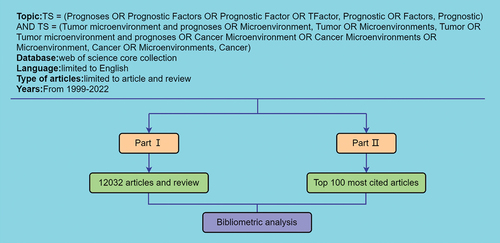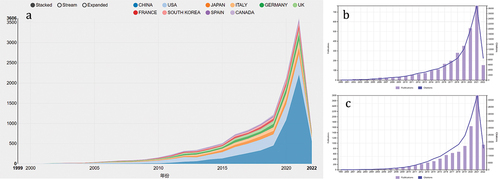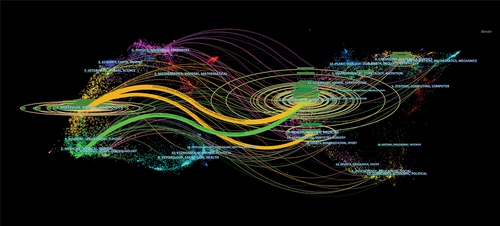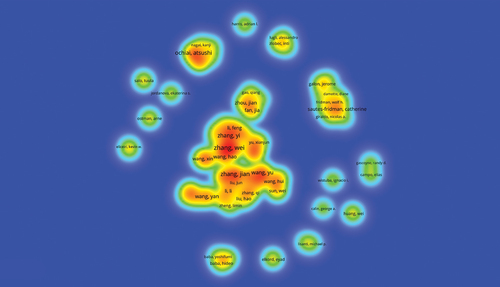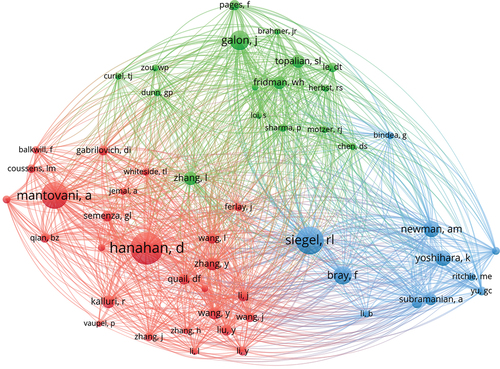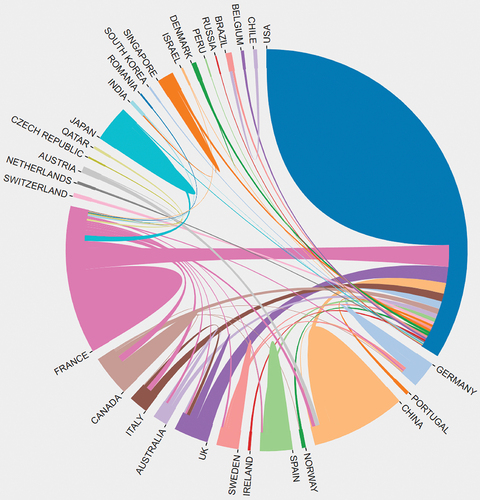ABSTRACT
To evaluate the temporal and spatial distribution of the knowledge network about tumor microenvironment and prognoses and explore new research hot spots and trends. Articles and reviews on tumor microenvironment and prognoses in the Web of Science journal from January 1999 to April 2022 were included. We used the CiteSpace and VOSviewer software to analyze the knowledge network composed of journals, institutions, countries, authors, and keywords. Frontiers in Immunology, Cancers, and Frontiers in Oncology have published more than 10% of articles in this field. China and the United States have contributed the most articles. Fudan University and Sun Yat-Sen University are the most active institutions. The authors in this field work closely; Zhang Wei and Douglas have made outstanding contributions. The three main research areas of tumor microenvironment and prognoses are microenvironment, prognosis, and immunotherapy. Until 2020, the main keywords were endothelial growth factor and adhesion. In the past three years, survival analysis, immune cell infiltration, and prediction model have been used. It can be seen that the focus in this field has shifted from tumor cell behavior and directly related molecules to prognosis prediction and non-tumor cells in the microenvironment. The future research trend may be to study the changes in the tumor microenvironment to predict the prognosis and guide the treatment. VOSviewer, CiteSpace, and Microsoft Excel 2019 were used to conduct a comprehensive visual analysis of the research on tumor environment and prognoses and provide valuable reference materials for researchers.
Introduction
The tumor is a complex term referring to not just the tumor cells but a series of components and its interaction with the surrounding microenvironment plays a decisive role in its occurrence and development. It has become a research hot spot in recent years.Citation1,Citation2 As George bebis mentionedCitation3 in a document published in 2022: “Tumors undergo dynamic spatiotemporal changes during their progression and response to treatment.” To make the treatment strategy adaptive, we need to emphasize the cells or molecules in the tumor microenvironment that can predict the occurrence and development of tumors. The tumor microenvironment refers to a local integrated system composed of tumor cells, some host cells, the secretory products of these cells, and the extracellular matrix. It can support tumor growth, inhibit immune response, and promote tumor development and metastasis.Citation4–6 Extensive research on the tumor microenvironment can provide good prognostic indicators.Citation1,Citation7 An important component of the tumor microenvironment is a variety of different immune cells, including CD4+ and CD8+ Teff cells,Citation8,Citation9 which play a key role in adaptive immunity against tumor cells. Their function largely depends on whether immune checkpoints are selectively activated by tumor cells. For example, in the tumor microenvironment, tumor cells can selectively activate PD-1 and CTLA-4. When PD-1 on T cells is overactivated, it inhibits T cell proliferation through the PI3K/AKT pathway,Citation10 reducing the cytotoxicity of T cells.Citation11,Citation12 In the long term, this leads to a significant reduction in the number of effector T cells in the tumor microenvironment, providing the basic conditions for tumor immune evasion. Similarly, overactivation of CTLA-4 inhibits CD28 co-stimulation, leading to a weakening of T cell proliferation signals. This results in a decrease in CD8 T cells and Th1-like CD1 effector T cells in the tumor microenvironment, contributing to tumor growth and metastasis.Citation13 These cellular and molecular changes not only indicate the evolving nature of the tumor microenvironment but also provide valuable indicators for predicting patient prognosis. Bibliometrics is a crucial method for building a knowledge network.Citation14,Citation15 It can reveal the logical connections hidden in the journal papers, such as the cooperative relationship between authors, the frequency of keyword co-occurrence, and the aggregation of national institutions.Citation14–18 Bibliometrics visualizes the information, a traditional meta-analysis, summarizes what cannot be done, and guides the readers to discover the development in trends and hot spots in this field.Citation19 Therefore, bibliometrics is becoming increasingly important. We objectively described the tumor microenvironment’s knowledge structure and development trend, and prognoses using VOSviewer and CiteSpace. 1). We analyzed annual publications, periodicals, and jointly cited periodicals to determine the focus areas of research in this field 2). The general information about the study was identified by analyzing the countries/regions, institutions, authors, and co-cited authors of the articles 3). We found the critical papers in this field and evaluated the knowledge base of tumor microenvironment and prognoses by analyzing the high centrality and cited literature 4). The critical knowledge composition and changes in hot spots and trends were determined using keyword co-occurrence frequency and co-cited literature 5). Finally, we confirmed and redetermined the research content in this field to find a possible direction for future research by analyzing the keyword co-occurrence of Top 100 articles, journals, co-cited journals, and national distribution, confirm and redetermine the research content in this field to find the possible direction of future research.
Material and method
This study used bibliometric methods to analyze journal articles in the field of tumor microenvironment and prognoses. The research content was divided into two parts. In the first part, we analyzed all the published articles on the tumor microenvironment and prognoses using the database Web of Science Core Collection (WoSCC). The second part was to analyze the top 100 highly cited literature in the field of tumor microenvironment and prognoses.
Data collection
The WoSCC is an influential database with comprehensive information required for bibliometrics.Citation15–18–Citation20–23 Therefore, we chose this database. On April 16, 2022, we started the following search type on WoSCC: TS = (Prognoses OR Prognostic Factors OR Prognostic Factor OR TFactor, Prognostic OR Factors, Prognostic) AND TS = (Tumor microenvironment and prognoses OR Microenvironment, Tumor OR Microenvironments, Tumor OR Tumor microenvironment and prognoses OR Cancer Microenvironment OR Cancer Microenvironments OR Microenvironment, Cancer OR Microenvironments, Cancer). The article type was limited to articles and reviews, and the article language was English. The data were obtained in two parts: 1. relevant articles from the establishment of the Web of Science (WoS) until April 16, 2022, and 2. 100 articles with the highest number of citations. All the data obtained were downloaded in the “plain text” format with the data type “full record and cited references.” Since CiteSpace can only recognize the “download *.txt” file type, the file name was modified for analysis.
Data analysis and visualization
Bibliometrics emphasizes using mathematical statistics to visually analyze the structure of a particular knowledge field.Citation18–20–Citation24–26 Since commonly used software has different advantages, CiteSpace5.7 and VOSviewer1.6.15 were used in this study. VOSviewer is a bibliometrics software developed by Leiden University’s Center for Science and Technology Studies in the Netherlands for data visualization.Citation27 We chose it for its excellent co-occurrence clustering function. We used VOSviewer to visually analyze the occurrence frequency of keywords, the relationship between keywords, and the occurrence density of authors and their teams.Citation28 Based on the data mentioned earlier, the co-occurrence and cluster graphs of keywords and authors in this research field were created. First, we removed the duplicate data, cleaned the data, and merged different ways of writing the same author’s name, such as “Fridman, wolf Herman” and “Fridman, wolf h..” We also unified different ways of writing the keywords, such as “tumor microenvironment and prognoses” and “tumor microenvironment.” Then, we set the minimum number of citations to 450 in the keyword co-occurrence analysis, and the keyword with the lowest frequency of 65 was selected.Citation29 Other corresponding thresholds were set according to different situations. CiteSpace is a visualization software based on the Java platform.Citation30 CiteSpace was used to analyze journals, cited journals, countries and institutions, and keywords. We de-duplicated and cleaned the data. For example, the documents of Hong Kong and Taiwan were classified as China.Citation29 The same countries with different writing styles were merged, and one of the writing styles was retained.Citation31 In keyword analysis, the exact words with multiple writing methods, such as cd8+ and CD8 (+), tumor microenvironment and microenvironment, Centsouth Univ and Cents Univ, were merged. CiteSpace settings were as follows: time span − 1999–2022, years per slice − 1, pruning – minimum spanning tree and pruning sliced networks, selection criteria – top n = 50, and others followed the default. We used Microsoft Office Excel 2019 to analyze annual publications. The data source of impact factors and JCR distribution until April 21, 2022, was WoS Journal Citation Reports.
Results
Annual growth trend
We formulated the following criteria for the inclusion of literature: the article types were research and review, the article language was English, and the publication time was from 1999 to 2022. Repetitive and irrelevant articles are excluded. Finally, among the 13,343 articles 12,032 articles were selected according to the inclusion and exclusion criteria. It can be seen from that this field has gained significant attention in recent years. From 2019 to 2021, the total number of research publications and citations in this field were 1,906 and 29,000. The full review publications and citations were 418 and 16,958, respectively. These numbers are much higher than the number of publications and citations (892 and 24,354, respectively) and the number of review publications and citations (347 and 12,068, respectively) from 1999 to 2017. In addition, among the ten countries with the highest number of publications, the United States stood first from 1999 to 2016. Since 2017, China has shown great enthusiasm in this field, becoming the country with the most published literature ().
Journals and co-cited journals
VOSviewer was used to analyze the journal co-occurrence and co-citation to find the most frequently read and influential journals in the field of tumor microenvironment and prognoses. The results of the co-occurrence analysis revealed that 12,032 articles were published in 1,502 academic journals. Among them, Frontiers in Oncology published 628 articles, accounting for 4.82% of the total. It is the journal with the most significant number of published articles. The competitors are Frontiers in oncology, Cancers and Frontiers in Immunology (Supplementary Table S1). Seven of the top 10 journals with the most published articles are in the Q1 JCR division. The impact factors of all journals except for scientific reports exceed 5. The journals of Switzerland and the United States are very active in this field, both accounting for 4/10 journals. The citation analysis results showed that 321 cited journals, among which 12 have been cited more than 5,000 times. Cancer Research was cited 8,915 times, ranking first, accounting for 4.35% of the total number of citations, followed by Clinical Cancer Research, Nature, and Cell (Supplementary Table S2). Seven of the ten most cited journals are in the Q1 JCR division. Except for PLOS One and the International Journal of Cancer, the impact factors of other journals exceed 10.
The United States has made outstanding contributions to the total citations, accounting for 7/10. CiteSpace was used to analyze the relationship between citing journals and cited journals.Citation32 As shown in , On the left are cited journals, and on the right are citing journals. The orange and green paths in the figure represent that the research published in the molecular biology/immunology journal is mainly cited by the research published in the journals of health/nursing/medicine and molecular biology/genetics. In contrast, the research published in the journal of medicine/medical/clinical is mainly cited by the research published in the journal of molecular biology/genetics.
Countries/regions and institutions
We obtained 12,032 documents from 105 countries and regions and 8,867 institutions. Among them, China ranks first with 5,308 articles, accounting for 34.14% of the total articles, followed by the United States (2,679, 17.23%), Japan (798, 5.13%), and Italy (745, 4.79%). The purplish-red nodes in the figure represent the high medium centrality, which means the turning point and connection hub.Citation30,Citation33,Citation34 shows that the high centrality nodes include the United States, Italy, and Germany. According to the branch color, the United States (1999) and Poland (1999) were the first to conduct such research. In practice, we used the minimum spanning tree and practiced sliced networks to process the data to obtain a more transparent network. The co-occurrence map of the countries and regions in the data before processing contains 105 nodes and 835 links. More links indicate more active cooperation among countries. Among the top 10 organizations producing articles are nine Chinese organizations and one American organization (). Among them, Fudan University (415, 2.94%) published the most papers, followed by Sun Yat-Sen University (406, 2.88%) and Shanghai Jiao Tong University (289, 2.05%) (Supplementary Table S3 and Table S4).
Figure 3. Co-occurrence map of (a) countries and (b) research institutions. The node size represents the co-occurrence frequency, and the line indicates their relationship. The color represents the year. From 1999 to 2022, the color varies from gray to red. Purple nodes indicate high centrality (>0.1).
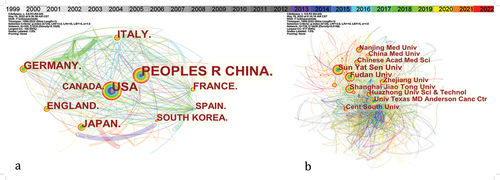
Authors and co-cited authors
To identify the authors and author groups that have made great contributions in this field, we selected ten from the 67,825 authors doing research in this field whose articles have been cited more than 500 times and published more than 34 papers. Among them (), Zhang Wei has published the most articles (n = 56), ranking first, Zhang Jiang (n = 47), Wang Wei (n = 46), Zhang Yi (n = 45), and Atsushi (n = 43) ranked second, third, fourth, and fifth, respectively. Then, we selected authors with more than ten articles to draw to show high output authors and closely related author groups. It can be seen from that the author group represented by Zhang Wei, Wang Hao, and Zhang Yi has the deepest color, indicating that they have made great contributions to the research in this field. In the second place is the author group represented by Zhang Jiang, Wang Yu, and Wang Yan. The third is the author group composed of Atsushi, Nagai, and Kanji. Among the 188,618 cited authors, 11 were cited more than 800 times. Douglas(n = 1,984) ranked first, followed by Rebecca (n = 1,705), Alberto (n = 1,648), Galon J (n = 1,200), and Freddie (n = 1,126). The citation numbers of the other six authors ranged from 803 to 992 (Supplementary Table S5 and Table S6). We selected 53 authors who were cited more than 800 times for analysis. As shown in , we can see that the authors are divided into three clusters. Some authors work closely together in different clusters, such as Hanahan D and Siegel RL.
Keyword co-occurrence, clusters, and evolution
We used VOSviewer to find the frequency, clustering, and evolution of 14,574 keywords. We found 54 keywords that appeared more than 100 times and drew a keyword density graph and clustering graph based on this (). We can derive from the keyword density graph () that immunotherapy is the most used keyword in this field after tumor microenvironment and prognoses. It has appeared 1,096 times (1.99%), followed by immune checkpoint inhibitor, blast cancer, hepatocellular carcinoma, metastasis, chromatic cancer, hyperoxia, biomarker, gaussian, and cancer (Supplementary Table S7). The keyword clustering analysis aims to show this field’s knowledge structureCitation26 (20). We got three different clusters according to the degree of correlation between keywords. Cluster 1 contained 21 keywords related to tumor microenvironment: tumor microenvironment, breast cancer, metastasis, colorectal cancer, hyperoxia, angiogenesis, pancreatic cancer, glioblastoma, and inflammation. Cluster 2 contained 19 keywords summarizing the relationship between immunotherapy and tumor microenvironment: immune checkpoint inhibitor, immunotherapy, ovarian cancer, biomarkers, immunohistochemistry, melanoma, and tumor-infiltrating lymphocytes. Cluster 3 contained 14 keywords mainly related to prognosis: prognosis, biomarker, immune information, survival, immune, bioinformatics, overall survival, and diagnostic signature. Using CiteSpace, we could see that the high-frequency keywords changed in different years. To better describe the research focus in different years to find the evolution trend of hot spots in this field, we selected the two keywords with the highest frequency each year to draw the time zone map (). The connection’s color and the abscissa identification represent the corresponding year when the keyword appears. Among the keywords that have appeared in the past three years, the keywords related to immunity (CXCL9, immune cell infiltration) and prognosis (survival analysis, prognostic signature) have increased significantly, indicating that they may become research hot spots in the future.
Figure 6. The density map of terms in tumor microenvironment and prognoses research. The size of words and nodes is consistent with the number of the co-occurrence frequencies, and the red color represents the high frequency of co-occurrence.

Figure 7. Keyword co-occurrence network and clusters in tumor microenvironment and prognoses research. Notes: the size of words and nodes are consistent with the number of the co-occurrence frequencies, the link shows the co-occurrence relationship, and the node with the same color represents the same cluster.
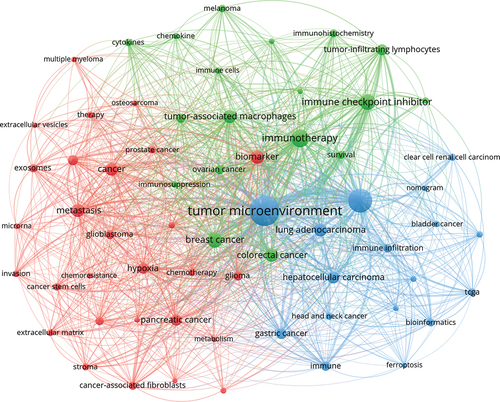
Figure 8. Three keywords with the highest frequency each year are shown. The size of the words and crosses shows the co-occurrence frequencies, and the link shows the co-occurrence relationship. The color of the cross and line represents time information. Grey to red colors represents the years from 1999 to 2022.
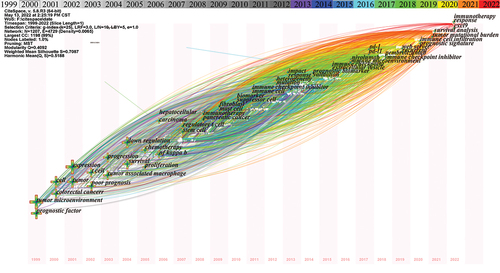
Co-cited reference and reference burst
Highly co-cited literature has a critical position in this field. We used CiteSpace to analyze such documents (Supplementary Table S8). The top two of the top 10 co-cited documents are “hallmarks of cancer: the next generation.” published by Douglas on the Cell in 2011, and “global cancer statistics 2018: GLOBOCAN estimates of incident and mortality worldwide for 36 cancers in 185 countries.” published by Freddie on CA: A Cancer Journal for Clinicians (CA Cancer J Clin) in 2018.Citation35,Citation36 We can determine the hot spot tendency over time by analyzing the references with citation bursts.Citation34 We used CiteSpace to analyze the top 35 references (). Currently, three references (3/35, 8.6%), published in CA Cancer J Clin, Nature Medicine, and Nucleic Acids Research, have the status of citation-burst. The paper with the strongest burstiness (intensity = 147.1) is “Hallmarks of cancer: the next generation.” published by Douglas et al. in Cell (2011).Citation35 In 2013, there were many papers with burstiness (5/35, 14.3%), followed by 2015 (6/35, 17.1%). Until 2020, four papers (20%) were still in citation-burst, among which “Hallmarks of cancer: the next generation.” (strength = 90.68) was the most powerful one.
Top 100 cited articles
We analyzed the journals and co-cited journals (Supplementary Tables S9-S11, and ) of the top 100 articles related to the research on tumor microenvironment and prognoses. The journals publishing this highly cited literature mainly involve three fields: immunology, oncology, and cell biology. The top journal in the field of immunology is Frontiers in Immunology (n = 18). In oncology, Cancer Research (n = 10)is ranked the top one. Oncogene (n = 14) ranks first in cell biology-related field. It can be seen that Frontiers in Immunology, Cancer Research, and Oncogene play important roles in this field. The top 100 journals only identified an orange main citation path (), indicating that the research published in molecular biology/immunology journals is mainly cited by the research published in molecular biology/genetics journals. We also analyzed the top 100 countries (). The country with the largest number of publications is United States (n = 62), followed by China (n = 17), Italy (n = 11), and France (n = 11). To further analyze the development contents and trends in the tumor microenvironment and prognoses, we analyzed the keywords of the top 100 articles and divided them into three clusters according to the link strength of keyword co-occurrence (). Cluster 1 (red) has 18 terms: diagnosis, cancer, tumor microenvironment and prognoses, survival, colorectal cancer, regulatory T-cells, metastasis, etc. The theme of cluster 1 is tumor microenvironment and prognosis. Cluster 2 (green) contains 13 terms related to the mechanism of tumor progression: expression, breast cancer, endogenous growth factor, angiogenesis, cells, growth, hyperoxia, extractive matrix, oxidative stress, lung cancer, mechanisms, NF-kappa-B, and prostate cancer. Cluster 3 (blue) contains nine terms related to the relevant mechanisms of the tumor microenvironment: progress, macrophages, mouse model, tumor-associated macrophages, activation, ductal adenocarcinoma, in vivo, stem cells, and suppressor cells.
Figure 10. Dual-map overlay of top 100 journals of tumor microenvironment and prognoses research. The color strip indicates the cited relationship. The right side is the cited journal, and the left side is the citing journal.
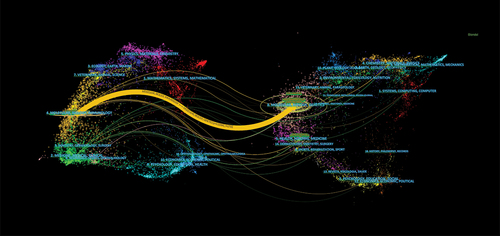
Figure 12. Network and clusters of keyword co-occurrence in tumor microenvironment and prognoses research. The size of the words and nodes are consistent with the number of the co-occurrence frequencies, the link shows the co-occurrence relationship, and the node with the same color represents the same cluster.
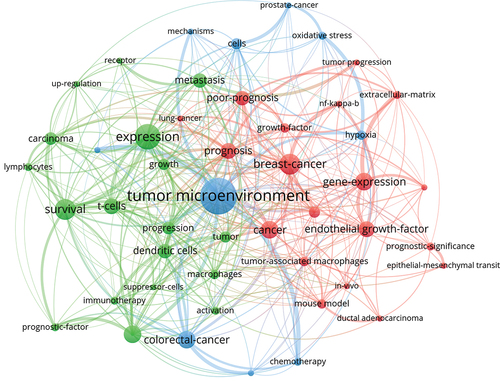
Discussion
General information
As of April 22, 2022, the WoSCC database has collected 12,032 studies on tumor microenvironment and prognoses from 8,867 institutions in 105 countries and regions, distributed among 67,825 authors and 1,502 journals. We selected the annual publications and citations of the literature in this field as the indicators to evaluate its development and found the following characteristics: research on tumor microenvironment and prognoses began in 1999.Citation37
Sreerama and Sacha found that the urokinase-type plasminogen activator (uPA) interacted with its receptor (uPAR) to promote proteolysis, tumor cell proliferation, and migration.Citation37 This opened the research related to tumor microenvironment and prognoses. Andrzej and Grzegorz predicted the prognosis of patients with laryngeal cancer through semi-quantitative and qualitative analysis of lymphocyte infiltration in the tumor microenvironment and correlation analysis between the intensity and components of lymphocyte infiltration.Citation38 This was the first time the tumor microenvironment and prognoses were linked. Since 2000, the focus on the tumor microenvironment and prognoses has increased yearly. The development in this field can be divided into several stages. During the initial stage of the study (1999 to 2004), this field did not receive much attention. The maximum annual publication volume was 32, and the only decrease in the publication volume in the research process decreased from 32 to 21 in 2003–2004. During the stage of stable increase (2004–2017), the number of relevant articles increased steadily, indicating that this field had attracted more scientists’ attention. From 2017 to now, the number of literature and citations has increased more than the total increase from 1999 to 2017, indicating that the field of tumor microenvironment and prognoses has entered a period of rapid development and become a hot spot in the field of tumor research.Citation39–41
As for journals and co-cited journals (Supplementary Table S1 and Table S2), Frontiers in Immunology, Cancer Research, and Frontiers in Oncology published 12% of the total research literature, and the rest of the journals published no more than 2%. Cancer Research has the highest number of citations. According to the information from the dual-map overlay of journals, we can see three main citation paths: molecular biology/immunology to molecular biology/genetics, molecular biology/immunology to health/nursing/medicine, and medicine/medical/clinical to molecular biology/genetics.Citation32 Among the top 10 published literature and the top 10 co-cited literature, the journals in the Q1 JCR area account for 70% and 90%, respectively, indicating that the research significance in the field of tumor microenvironment and prognoses has been recognized by the journals and researchers in relevant fields, and these journals play an essential role in this field. About the geographical distribution of this research (Supplementary Table S3 and ), China, the United States, Japan, Italy, and Germany are the five countries with the most published literature. Most of the revolutionary turning points in this field occurred in the United States, Germany, and Britain. The countries that made the earliest contributions to this field are the United States, Poland, Germany, and Britain. The United States is the most extensive cooperation center among different countries. Among the top ten institutions, nine are from China, and one is from the United States. The University of Texas MD Anderson Cancer Center, Fudan University, and Sun Yat-Sen University collaborate with other institutions, and most of the literature they published is in the top 10 positions, thus, making outstanding contributions to this field. We found the top 10 authors with the most published papers and the top 10 with the most citations by analyzing the literature (Supplementary Table S5 and Table S6, ). Zhang Wei published the most papers, and Hanahan was cited the most. The researchers in this field often have in-depth cooperation to form a closely related group. Understanding the high-yield and highly cited researcher groups will help us further grasp this field’s trends and research directions.Citation42,Citation43
Knowledge structure
The keyword co-occurrence and time zone graphs can effectively prompt the hot spots and their changes in a research field.Citation44,Citation45 According to our analysis in (Supplementary Table S7 , ), the keywords with high frequency in this field are tumor microenvironment and prognoses,immune checkpoint inhibitor, diagnosis, immunology, breast cancer, biomarker, tumor-associated macrophages, chromatic cancer, metastasis, and lung adenocarcinoma. We can assume that the research hot spots in this field mainly focus on the overall level of tumors from the keyword time zone map.Citation46–49 The keywords from 1999 to 2022 have an obvious evolution law. In the initial stage of the study, from 1999 to 2004, the keywords with the highest frequency of occurrence each year include survival, progress, T-cell, expression, chromatic cancer, tumor microenvironment, and prognoses. In the stable growth stage from 2004 to 2017, the annual high-frequency keywords changed from the overall level of the tumors to the cellular level, including the cells that constitute the tumor microenvironment, with equal emphasis on prognosis prediction and treatment, including immune checkpoint inhibitor,promotion, chemotherapy, NF kappa B, immunotherapy, fibroblast, biomarker, immune Cell, genetics, diagnostic biomarker, immune checkpoint, immune microenvironment, and molecular subtype. In the rapid growth stage from 2017 till now, there has been a tendency to predict the prognosis of patients by changes in the tumor microenvironment after immunotherapy (molecular subtype, immune checkpoint inhibitor, immune infection, diagnostic model, survival analysis, and CXCL9). It is worth noting that during the evolution of keywords for more than 20 years, the most central and high-frequency keywords still contain tumor microenvironment and prognoses, indicating that the research on tumor microenvironment for prognosis prediction is a potential research hot spot. Unfortunately, in the current research, many studies have focused on the impact of single cells and phenotypes in the tumor microenvironment. However, a tumor is a disease with a low overall survival rate. It is more necessary to form a model from the tumor microenvironment to prognostication to guide the treatment strategy and to control the occurrence and development of tumors in the early stages. The most important link is the tumor microenvironment screening and relevant molecules’ prediction ability. In this regard, gene analysis after immunotherapy is a potential hot spot. Keyword clustering can help us understand the knowledge structure in this field.Citation26 In , we can see that the three main clusters in this field are: tumor microenvironment, prognoses, and immunology. With the occurrence and development of a tumor, the interaction between cells and molecules in the tumor microenvironment leads to further development and metastasis of the tumor. In this process, detectable changes at the cellular and molecular levels provide the possibility to predict the prognosis of patients.Citation46–53 However, it is unclear how stromal and immune cells can inhibit or promote tumor changes in the complex environment of immunotherapy.Citation54,Citation55 Among them, signal transduction, key substances, and structures such as CXCL9 and cleavage are the focus, and the lack of research and exploration in this area is an important driving force to promote progress in this field.Citation56–59 In terms of disease, a complete detection, prediction, and treatment chain are our continuous efforts’ hot spot and direction. References with citation bursts in a field usually mean emerging topics.Citation60 It can be seen from that the most intense citation is the milestone review by Douglas et al. (intensity = 147.1), which was published in the Cell in 2011.Citation35 This article is also the most cited document. “Hallmarks of cancer: the next generation” is another significant contributor in this field. We have summarized the relationship between the eight physical abilities of tumors (evading growth suppressors, resisting cell death, enabling replicative immortality, sustaining proliferative signaling, inducing angiogenesis, activating invasion and metastasis, energy metabolism reprogramming, and immune evasion) and the tumor microenvironment. The literature with the second burst intensity (intensity = 90.68) was published in Nature Methods by Aaron et al. in 2015, and this citation burst lasted for two years (2019–2020).Citation61 This article proposed a new method for a large-scale analysis of biomarker RNA mixtures, which provided a new method for predicting prognosis through changes in the tumor microenvironment. Suzanne L et al. published papers in the New England Journal of Medicine in 2012 titled “Safety, activity, and immune correlates of anti-PD-1 antibody in cancer.”.Citation62 This study found that anti-PD-1 antibody in the T-cell can positively affect patients with non-small cell lung cancer, melanoma, or renal cell carcinoma. In 2011, Ahmedin et al. published the fourth-ranked document titled “Global cancer statistics” on CA-Cancer J Clin.Citation63 The literature collected and summarized the changes in the cancer incidence rate and early treatment methods and put forward the urgent need for cancer prognosis prediction. The fifth paper, “The immune contexture in human tumors: impact on clinical outcome,” was written by Wolf Herman et al. and was published in Nature Reviews Cancer (63.32, 2013–2017) in 2012.Citation64 This paper comprehensively analyzed the interaction between tumor cells, immune response, and tumor microenvironment and proposed that high levels of Th1, cytotoxic memory, T-cell density, and the tumor’s core or edge are all powerful prognostic factors. The sixth article, “Microenvironmental regulation of tumor progress and metastasis,” was published in Nature Medicine by Daniela F et al. in 2013 (58.77 2015–2018).Citation65 It proposed the contradictory role of the tumor microenvironment in specific stages of cancer progression and metastasis and the therapeutic attempt to interfere with stromal cells in the tumor microenvironment to produce an antitumor effect. It suggested that tumor cell-targeted drugs should be combined with the tumor microenvironment and key signaling pathways between different tumor types and tissues. In 2015, Matthew E et al. published the article “Limma powers differential expression analyses for RNA sequencing and microarray studies” (58.49 2019–2020) on Nucleic Acids Research, introducing the R/Bioconductor software package that can perform differential expression and splicing analysis on RNA-sequence data.Citation66 The software package can now surpass the traditional gene expression analysis in various ways. It provides powerful tool support for finding prognostic components in the tumor microenvironment. The articles ranked eighth and ninth were published by Rebecca et al. in CA-Cancer J Clin.Citation67,Citation68 A large number of statistical analyses of the illness and treatment of tumor patients revealed the prognosis differences caused by different regions, ethnic groups, and treatment conditions. The last article, “PD-1 blockade causes responses by inhibiting adaptive immune resistance”, was published in Nature (52.99 2015–2019) by Paul C et al. in 2014. It pointed out that tumor regression after PD-1 blockade depends on the preexisting CD8 + T-cells. The proliferation of CD8 + T-cells in the tumor of patients with metastatic melanoma is directly related to the reduction of tumor size in imaging.Citation69 The analysis of citations reveals a strong connection between the tumor microenvironment, immunotherapy, and prognosis prediction. Recently, the increased use of RNA analysis to explore the changes in the tumor microenvironment components and the regulation of stromal cells and PD-1 receptors on T-cells has attracted significant attention in this field. To improve the accuracy of the analysis, we used the cited Top 100 articles to analyze the journals, co-cited journals, countries, and keywords. Cancer Cell is the most published and cited journal in this field, indicating that Cancer Cell plays an important role. The dual-map overlay of the top 100 journals () reveals the citation path from molecular biology/immunology to molecular biology/genetics, indicating that these studies are mainly concentrated in the laboratory stage and have not been widely promoted to clinical practice.
The country analysis of the top 100 articles is slightly different from all. The top three output countries have changed from China, the United States, and Japan to the United States, France, and China. Both the United States and Germany have extensive international cooperation. The keyword analysis of the top 100 reveals that it is divided into three clusters, tumor microenvironment and prognoses, breast cancer, and expression. The results of the top 100 articles analysis were narrower than the whole cluster analysis, such as RNA expression and immunology of breast cancer. From the above analysis, we can conclude that the field of tumor microenvironment and prognoses initially focused on tumors and several topics related to primary immune cells. Later, with the discovery of other components and the role of cells that compose the tumor microenvironment (fibroblast, mast cell, NF kappa B, and biomarker), the research trend of predicting prognosis through the interaction and changes of non-cellular components, tumor cells, and immune cells in the tumor microenvironment gradually clarified.
Knowledge base and hot spot evolution
The co-cited documents refer to the references cited by multiple documents simultaneously, which is the common knowledge source of these documents. Knowledge base refers to the collection of co-cited documents, effectively reflecting the upper knowledge nodes recognized by researchers in this field.Citation34,Citation70,Citation71 In the top 15 co-cited references and top 15 burst cited references, 6 papers of annual cancer data statistics type are removed, and 7 same articles are obtained. These 7 articles can be regarded as a knowledge base in this field. We grouped the seven articles into three categories.
The co-cited documents refer to the references cited by multiple documents at the same time, which is the common knowledge source of these documents. Knowledge base refers to the collection of co-cited documents that can effectively reflect the upper knowledge nodes recognized by researchers in this field. The top 15 cited literature in this field are mentioned in (Supplementary Table S8) of them also exist in the top 15 strongest citation burst literature. These 7 works of literature well represent the knowledge base in this field.
In order to more clearly show the relationship between various parts of knowledge in this field, we divided these seven articles into three clusters. In 2011, Cell published the most co-cited study (n = 1173) “Hallmarks of cancer: the next generation” (29), which was written by Douglas et al. This paper adds two markers based on the six characteristics of tumors previously proposed, namely reprogramming of energy metabolism and avoiding immune damage. The authors also put forward a view that the development of tumor needs to be understood in combination with the tumor microenvironment. Daniela et al. published an article titled “Microenvironmental regulation of tumor progress and metastasis” in Nature Medicine (43) in 2013. It pointed out that there was a complex communication mechanism between tumor cells and the microenvironment. Therefore, targeting the tumor microenvironment is a promising treatment strategy to prevent metastasis and improve treatment effects. In 2012, Douglas et al. published a paper titled “Accessories to the crime: functions of cells recruited to the tumor microenvironment” (40) in Cancer Cell. The highlight of this paper is that a good therapeutic strategy not only targets tumor cells but also other pathways and mediators in the tumor microenvironment.
The above three articles illustrate the important value of tumor microenvironment targeted therapy and point out the exploration direction for this study.
In 2015, Aaron et al published a paper titled “Robust enumeration of cell subsets from tissue expression profiles” in Nature Medicine (41). In this paper, it is mentioned that in recent years, many studies have confirmed that the quantification of tumor-infiltrating immune cells is helpful to reveal the multifaceted role of the immune system in cancer. This paper introduces a method to characterize the composition of complex tissues and cells from gene expression profiles using ciberport. Using this software, we can conduct a large-scale analysis of cellular biomarkers and RNA of therapeutic targets, and quantify tumor-infiltrating immune cells from tumor RNA sequencing data. In 2015, Matthew et al. published “Limma powers differential expression analyses for RNA sequencing and microarray studies” in Nucleic Acids Research (44). In this article, the author mainly introduces an R/biological conductor software package named Limma. It is a comprehensive technology for analyzing microarrays and RNA Sequence differential analysis and provides an integrated solution for analyzing gene expression experimental data. This paper mainly reviews the design concept of the software package and emphasizes the newly added and previously undescribed functions.
These two articles summarize the most potential and popular gene analysis algorithms in the field of tumor microenvironment, and provide methodological support for finding predictive molecules through RNA analysis in the tumor microenvironment.
In 2012, Drew M et al. published a review article titled “The blockade of immune checkpoints in cancer immunotherapy” in Nat Rev Cancer (42). This article reveals that tumors will choose some immune checkpoint pathways as the main mechanism of immune resistance, especially against tumor antigen-specific T cells. The treatment of CTLA4 and PD-1 is very effective. In 2012, Wolf Herman et al. published “The immune contexture in human tumors: impact on clinical outcome” in Nat Rev Cancer (45). In this article, the author introduces the effects of different types of immune cells in tumor microenvironment on tumor growth.
These two articles revealed the changes of different types of immune cells, especially T cell immune checkpoint PD1 and CTLA4, in the tumor microenvironment and the key role of inhibiting tumor development.
After excluding the papers of annual cancer data statistical type, we obtained the co-cited top 3 articles in recent three years “Timer2.0 for analysis of tumor infiltrating immune cells,”Citation72 “A framework for advancing our understanding of cancer associated fibroblasts”Citation73 “B cells and tertiary inflammatory structures promote immune response”Citation74 and 3 articles still in burstness “Signatures of t cell dysfunction and exclusion predict cancer immune response,”Citation75 “Timer2.0 for analysis of tumor infiltrating immune cells,”Citation72 “Maftools: effective and comprehensive analysis of systemic variables in cancer”Citation76 that continue to erupt in 2022. It was found that targeted regulation of tumor microenvironment and understanding of changes of tumor microenvironment components such as immune cells through algorithms are still the latest hotspots, among which T cell related immune checkpoints CTLA-4 and PD1 are the most valuable.
Limitation
This study’s data source is WoSCC, a commonly used bibliometric analysis database.Citation15,Citation21 However, some documents that are not included in WoSCC will be omitted. Additionally, due to the subtle differences in parameter settings among many bibliometrics authors, the same data will inevitably have deviations.Citation77 However, this study’s results agree with the traditional reviews in this field, which provide meaningful reference and guidance for researchers.Citation78–81
Conclusion
This bibliometric analysis uses objective data to showcase the research trends and significant advancements in various stages of tumor microenvironment and prognosis research.It emphasizes potential future research directions: the development of closed-loop prognostic methods based on T cell PD1 and CTLA4 immune checkpoint alterations using algorithms and RNA analysis software.The current research status is as follows: (1) Therapeutic approaches targeting T cell immune checkpoints in the tumor microenvironment have been established, but the response rates among various cancer patients are not high. (2) Techniques involving algorithms and RNA analysis to understand the components of the tumor microenvironment have made significant progress. However, there is a lack of direct clinical relevance to cancer treatment. (3) Some molecular markers capable of predicting patient prognosis have been identified in the tumor microenvironment, but their sensitivity and specificity remain unsatisfactory.In summary, addressing the existing issues in current research, there is a need to further identify more effective, personalized, and dynamic treatment approaches. To enhance response rates among various cancer patients to immune checkpoint therapies, it is crucial to promptly utilize algorithms and RNA analysis to identify effective prognostic markers within a patient’s tumor microenvironment. Treatment plans should be dynamically and personalized adjusted based on changes in prognostic markers. PD1 and CTLA4 represent promising avenues for future research.This is the first time that the theme of closed-loop prognostic method based on T cell PD1 and CTLA4 immune checkpoint alterations using algorithms and RNA analysis has been analyzed through bibliometric analysis. We conducted data analysis using CiteSpace and VOSviewer, providing original and objective solutions for researching the tumor microenvironment and prognosis. We believe that these research findings will serve as valuable references for further investigations.
Author contributions
Conceptualization, XW, and QZ; methodology, SM, and ZW; software, ZW and SM; validation, XW, QZ, and SM; formal analysis, ZW; investigation, SM; resources, XW; data curation, ZW; writing – original draft preparation, XW; writing – review and editing, XW; visualization, XW; supervision, XW; project administration, XW; funding acquisition, QZ. All authors have read and agreed to the published version of the manuscript.
Supplementary Tables
Download PDF (271.1 KB)Acknowledgments
Xin wu would like to thank my wife Ethna for her unwavering support of this study.
Disclosure statement
No potential conflict of interest was reported by the author(s).
Data availability statement
The original contributions of this study are included in the article and supplementary material at http://www.webofscience.com/wos/woscc/basic-search. Further inquiries can be directed to the corresponding authors.
Supplementary material
Supplemental data for this article can be accessed on the publisher’s website at https://doi.org/10.1080/21645515.2023.2269788.
Additional information
Funding
References
- Pages F, Galon J, Dieu-Nosjean MC, Tartour E, Sautes-Fridman C, Fridman WH. Immune infiltration in human tumors: a prognostic factor that should not be ignored. Oncogene. 2010;29(8):1093–16. doi:10.1038/onc.2009.416.
- Pietras K, Ostman A. Hallmarks of cancer: interactions with the tumor stroma. Exp Cell Res. 2010;316(8):1324–31. doi:10.1016/j.yexcr.2010.02.045.
- Bebis G, Levy D, Rockne R, Lima E, Benos PV. Editorial: advances in mathematical and computational Oncology. Front Physiol. 2022;13:889198. doi:10.3389/fphys.2022.889198.
- Whiteside TL. The tumor microenvironment and its role in promoting tumor growth. Oncogene. 2008;27(45):5904–12. doi:10.1038/onc.2008.271.
- Joyce JA, Fearon DT. T cell exclusion, immune privilege, and the tumor microenvironment. Science. 2015;348(6230):74–80. doi:10.1126/science.aaa6204.
- Lynch CC, Matrisian LM. Matrix metalloproteinases in tumor - host cell communication. Differentiation. 2002;70(9–10):561–73. doi:10.1046/j.1432-0436.2002.700909.x.
- Budhu A, Forgues M, Ye QH, Jia H-L, He P, Zanetti KA, Kammula US, Chen Y, Qin L-X, Tang Z-Y, et al. Prediction of venous metastases, recurrence, and prognosis in hepatocellular carcinoma based on a unique immune response signature of the liver microenvironment. Cancer Cell. 2006;10(2):99–111. doi:10.1016/j.ccr.2006.06.016.
- Leone RD, Powell JD. Metabolism of immune cells in cancer. Nat Rev Cancer. 2020;20(9):516–31. doi:10.1038/s41568-020-0273-y.
- Arneth B. Tumor microenvironment. Med (Kaunas). 2019;56(1):15. doi:10.3390/medicina56010015.
- Jiang D, Wu X, Sun X, Tan W, Dai X, Xie Y, Du A, Zhao Q. Bone mesenchymal stem cell-derived exosomal microRNA-7-5p inhibits progression of acute myeloid leukemia by targeting OSBPL11. J Nanobiotechnol. 2022;20(1):29. doi:10.1186/s12951-021-01206-7.
- Zhang H, Dai Z, Wu W, Wang Z, Zhang N, Zhang L, Zeng W-J, Liu Z, Cheng Q. Regulatory mechanisms of immune checkpoints PD-L1 and CTLA-4 in cancer. J Exp Clin Cancer Res. 2021;40(1):184. doi:10.1186/s13046-021-01987-7.
- Du A, Yang Q, Sun X, Zhao Q. Exosomal circRNA-001264 promotes AML immunosuppression through induction of M2-like macrophages and PD-L1 overexpression. Int Immunopharmacol. 2023;124(Pt A):110868. doi:10.1016/j.intimp.2023.110868.
- Nishimura CD, Pulanco MC, Cui W, Lu L, Zang X. PD-L1 and B7-1 Cis-interaction: new mechanisms in immune checkpoints and immunotherapies. Trends Mol Med. 2021;27(3):207–19. doi:10.1016/j.molmed.2020.10.004.
- Mulet-Forteza C, Lunn E, Merigó JM, Horrach P. Research progress in tourism, leisure and hospitality in Europe (1969–2018). Int J Contemp Hosp Manage. 2021;33(1):48–74. doi:10.1108/IJCHM-06-2020-0521.
- Ke L, Lu C, Shen R, Lu T, Ma B, Hua Y. Knowledge mapping of drug-induced liver injury: a scientometric investigation (2010-2019). Front Pharmacol. 2020;11:842. doi:10.3389/fphar.2020.00842.
- Devos P, Ménard J. Trends in worldwide research in hypertension over the period 1999-2018: a bibliometric study. Hypertension. 2020;76(5):1649–55. doi:10.1161/HYPERTENSIONAHA.120.15711.
- Chen C, Song M, Glanzel W. Visualizing a field of research: a methodology of systematic scientometric reviews. PloS One. 2019;14(10):e0223994. doi:10.1371/journal.pone.0223994.
- Ma C, Su H, Li H. Global research trends on prostate diseases and erectile dysfunction: a bibliometric and visualized study. Front Oncol. 2020;10:627891. doi:10.3389/fonc.2020.627891.
- Chen C, Lou Y, Li XY, Lv ZT, Zhang LQ, Mao W. Mapping current research and identifying hotspots on mesenchymal stem cells in cardiovascular disease. Stem Cell Res Ther. 2020;11(1):498. doi:10.1186/s13287-020-02009-7.
- Huang X, Fan X, Ying J, Chen S. Emerging trends and research foci in gastrointestinal microbiome. J Transl Med. 2019;17(1):67. doi:10.1186/s12967-019-1810-x.
- Mulet-Forteza C, Genovart-Balaguer J, Mauleon-Mendez E, Merigó JM. A bibliometric research in the tourism, leisure and hospitality fields. J Bus Res. 2019;101:819–27. doi:10.1016/j.jbusres.2018.12.002.
- Zhu X, Kong Q, Niu X, Chen L, Ge C. Mapping intellectual structure and research performance for the nanoparticles in pancreatic cancer field. Int J Nanomed. 2020;15: 5503–16. 10.2147/IJN.S253599.
- Zhang XL, Zheng Y, Xia ML, Wu Y-N, Liu X-J, Xie S-K, Wu Y-F, Wang M. Knowledge domain and emerging trends in vinegar research: a bibliometric review of the literature from WoSCC. Foods. 2020;9(2):166. doi:10.3390/foods9020166.
- Chen L, Ma S, Hu D, Lin H, Zhu Y, Chen K, Chen L, Zheng C, Liu J, Liao Y, et al. Bibliometric study of sodium glucose cotransporter 2 inhibitors in cardiovascular research. Front Pharmacol. 2020;11:561494. doi:10.3389/fphar.2020.561494.
- Merigó JM, Mulet-Forteza C, Valencia C, Lew AA. Twenty years of tourism geographies: a bibliometric overview. Tourism Geogr. 2019;21(5):881–910. doi:10.1080/14616688.2019.1666913.
- Qin Y, Zhang Q, Liu Y. Analysis of knowledge bases and research focuses of cerebral ischemia-reperfusion from the perspective of mapping knowledge domain. Brain Res Bull. 2020;156:15–24. doi:10.1016/j.brainresbull.2019.12.004.
- van Eck NJ, Waltman L. Software survey: VOSviewer, a computer program for bibliometric mapping. Scientometrics. 2010;84(2):523–38. doi:10.1007/s11192-009-0146-3.
- Paunkov A, Chartoumpekis DV, Ziros PG, Sykiotis GP. A bibliometric review of the Keap1/Nrf2 pathway and its related antioxidant compounds. Antioxid (Basel). 2019;8(9):353. doi:10.3390/antiox8090353.
- Gao Y, Shi S, Ma W, Chen J, Cai Y, Ge L, Li L, Wu J, Tian J. Bibliometric analysis of global research on PD-1 and PD-L1 in the field of cancer. Int Immunopharmacol. 2019;72:374–84. doi:10.1016/j.intimp.2019.03.045.
- Chen C. Searching for intellectual turning points: progressive knowledge domain visualization. Proc Natl Acad Sci U S A. 2004;101 Suppl 1(Suppl 1):5303–10. doi:10.1073/pnas.0307513100.
- Mulet-Forteza C, Genovart-Balaguer J, Merigó JM, Mauleon-Mendez E. Bibliometric structure of IJCHM in its 30 years. Int J Contemp Hosp Manage. 2019;31(12):4574–604. doi:10.1108/IJCHM-10-2018-0828.
- Chen C, Leydesdorff L. Patterns of connections and movements in dual-map overlays: a new method of publication portfolio analysis. J Assoc Inf Sci Technol. 2014;65(2):334–51. doi:10.1002/asi.22968.
- Chen C, Hu Z, Liu S, Tseng H. Emerging trends in regenerative medicine: a scientometric analysis in CiteSpace. Expert Opin Biol Ther. 2012;12(5):593–608. doi:10.1517/14712598.2012.674507.
- Chen C. Science mapping: a systematic review of the literature. J Data Inf Sci. 2017;2(2):1–40. doi:10.1515/jdis-2017-0006.
- Hanahan D, Weinberg RA. Hallmarks of cancer: the next generation. Cell. 2011;144(5):646–74. doi:10.1016/j.cell.2011.02.013.
- Bray F, Ferlay J, Soerjomataram I, Siegel RL, Torre LA, Jemal A. Global cancer statistics 2018: GLOBOCAN estimates of incidence and mortality worldwide for 36 cancers in 185 countries. CA Cancer J Clin. 2018;68(6):394–424. doi:10.3322/caac.21492.
- Shetty S, Idell S. Posttranscriptional regulation of urokinase receptor gene expression in human lung carcinoma and mesothelioma cells in vitro. Mol Cell Biochem. 1999;199(1–2):189–200. doi:10.1023/A:1006914800447.
- Morawski K, Gabriel A, Namyslowski G, Ziólkowski A, Pietrawska V, Steplewska K. Clinical application of proliferating cell nuclear antigen, oncoprotein p53 and tumor front grading analysis in patients operated on for laryngeal cancer. Eur Arch Otorhinolaryngol. 1999;256(8):378–83. doi:10.1007/s004050050168.
- Czekay RP, Cheon DJ, Samarakoon R, Kutz SM, Higgins PJ. Cancer-associated fibroblasts: mechanisms of tumor progression and novel therapeutic targets. Cancers. 2022;14(5):29. doi:10.3390/cancers14051231.
- Shum B, Larkin J, Turajlic S. Predictive biomarkers for response to immune checkpoint inhibition. Semin Cancer Biol. 2022;79:4–17. doi:10.1016/j.semcancer.2021.03.036.
- Yang KY, Wu ZJ, Zhang H, Zhang N, Wu W, Wang Z, Dai Z, Zhang X, Zhang L, Peng Y, et al. Glioma targeted therapy: insight into future of molecular approaches. Mol Cancer. 2022;21(1):32. doi:10.1186/s12943-022-01513-z.
- Kodonas K, Fardi A, Gogos C, Economides N. Scientometric analysis of vital pulp therapy studies. Int Endod J. 2021;54(2):220–30. doi:10.1111/iej.13422.
- Liang YD, Li Y, Zhao J, Wang XY, Zhu HZ, Chen XH. Study of acupuncture for low back pain in recent 20 years: a bibliometric analysis via CiteSpace. J Pain Res. 2017;10:951–64. doi:10.2147/JPR.S132808.
- Xiao F, Li C, Sun J, Zhang L. Knowledge domain and emerging trends in organic photovoltaic technology: a scientometric review based on citespace analysis. Front Chem. 2017;5:67. doi:10.3389/fchem.2017.00067.
- Liu G, Jiang R, Jin Y. Sciatic nerve injury repair: a visualized analysis of research fronts and development trends. Neural Regen Res. 2014;9(18):1716–22. doi:10.4103/1673-5374.141810.
- Burger JA, Kipps TJ. CXCR4: a key receptor in the crosstalk between tumor cells and their microenvironment. Blood. 2006;107(5):1761–7. doi:10.1182/blood-2005-08-3182.
- Woo SR, Fuertes MB, Corrales L, Spranger S, Furdyna M, Leung MK, Duggan R, Wang Y, Barber G, Fitzgerald K, et al. Sting-dependent cytosolic DNA sensing mediates innate immune recognition of immunogenic tumors. Immunity. 2014;41(5):830–42. doi:10.1016/j.immuni.2014.10.017.
- Zeng DQ, Li MY, Zhou R, Zhang J, Sun H, Shi M, Bin J, Liao Y, Rao J, Liao W, et al. Tumor microenvironment characterization in gastric cancer identifies prognostic and immunotherapeutically relevant gene signatures. Cancer Immunol Res. 2019;7(5):737–50. doi:10.1158/2326-6066.CIR-18-0436.
- Disis ML. Immune regulation of cancer. J Clin Oncol. 2010;28(29):4531–8. doi:10.1200/JCO.2009.27.2146.
- DeNardo DG, Brennan DJ, Rexhepaj E, Ruffell B, Shiao SL, Madden SF, Gallagher WM, Wadhwani N, Keil SD, Junaid SA, et al. Leukocyte complexity predicts breast cancer survival and functionally regulates response to chemotherapy. Cancer Discov. 2011;1(1):54–67. doi:10.1158/2159-8274.CD-10-0028.
- Mu CY, Huang JA, Chen Y, Chen C, Zhang XG. High expression of PD-L1 in lung cancer may contribute to poor prognosis and tumor cells immune escape through suppressing tumor infiltrating dendritic cells maturation. Medical Oncol. 2011;28(3):682–8. doi:10.1007/s12032-010-9515-2.
- Zhang JP, Yan J, Xu J, Pang X-H, Chen M-S, Li L, Wu C, Li S-P, Zheng L. Increased intratumoral IL-17-producing cells survival in hepatocellular carcinoma correlate with poor patients. J Hepatol. 2009;50(5):980–9. doi:10.1016/j.jhep.2008.12.033.
- Qian BZ, Li JF, Zhang H, Kitamura T, Zhang J, Campion LR, Kaiser EA, Snyder LA, Pollard JW. CCL2 recruits inflammatory monocytes to facilitate breast-tumour metastasis. Nature. 2011;475(7355):222–U129. doi:10.1038/nature10138.
- Galand C, Donnou S, Molina TJ, Fridman WH, Fisson S, Sautès-Fridman C. Influence of tumor location on the composition of immune infiltrate and its impact on patient survival. Lessons from DCBCL and animal models. Front Immunol. 2012;3:98. doi:10.3389/fimmu.2012.00098.
- Senovilla L, Vacchelli E, Galon J, Adjemian S, Eggermont A, Fridman WH, Sautès-Fridman C, Ma Y, Tartour E, Zitvogel L, et al. Trial watch: prognostic and predictive value of the immune infiltrate in cancer. Oncoimmunology. 2012;1(8):1323–43. doi:10.4161/onci.22009.
- Gao HF, Cheng CS, Tang J, Li Y, Chen H, Meng Z-Q, Chen Z, Chen L-Y. CXCL9 chemokine promotes the progression of human pancreatic adenocarcinoma through STAT3-dependent cytotoxic T lymphocyte suppression. Aging-Us. 2020;12(1):502–17. doi:10.18632/aging.102638.
- Lieber S, Reinartz S, Raifer H, Finkernagel F, Dreyer T, Bronger H, Jansen JM, Wagner U, Worzfeld T, Müller R, et al. Prognosis of ovarian cancer is associated with effector memory CD8 + T cell accumulation in ascites, CXCL9 levels and activation-triggered signal transduction in T cells. Oncoimmunology. 2018;7(5):9. doi:10.1080/2162402X.2018.1424672.
- Razis E, Kalogeras KT, Kotsantis I, Koliou G-A, Manousou K, Wirtz R, Veltrup E, Patsea H, Poulakaki N, Dionysopoulos D, et al. The role of CXCL13 and CXCL9 in early breast cancer. Clin Breast Cancer. 2020;20(1):E36–E53. doi:10.1016/j.clbc.2019.08.008.
- Singh P, Blatt A, Feld S, Zohar Y, Saadi E, Barki-Harrington L, Hammond E, Ilan N, Vlodavsky I, Chowers Y, et al. The heparanase inhibitor PG545 attenuates colon cancer initiation and growth, associating with increased p21 Expression(1). Neoplasia. 2017;19(3):175–84. doi:10.1016/j.neo.2016.12.001.
- Chen C, Dubin R, Kim MC. Orphan drugs and rare diseases: a scientometric review (2000 – 2014). Expert Opin Orphan Drugs. 2014;2(7):709–24. doi:10.1517/21678707.2014.920251.
- Newman AM, Liu CL, Green MR, Gentles AJ, Feng W, Xu Y, Hoang CD, Diehn M, Alizadeh AA. Robust enumeration of cell subsets from tissue expression profiles. Nat Methods. 2015;12(5):453–7. doi:10.1038/nmeth.3337.
- Topalian SL, Hodi FS, Brahmer JR, Gettinger SN, Smith DC, McDermott DF, Powderly JD, Carvajal RD, Sosman JA, Atkins MB, et al. Safety, activity, and immune correlates of anti–PD-1 antibody in cancer. N Engl J Med. 2012;366(26):2443–54. doi:10.1056/NEJMoa1200690.
- Jemal A, Bray F, Center MM, Ferlay J, Ward E, Forman D. Global cancer statistics. CA Cancer J Clin. 2011;61(2):69–90. doi:10.3322/caac.20107.
- Senovilla L, Vacchelli E, Galon J, Adjemian S, Eggermont A, Fridman WH, Sautès-Fridman C, Ma Y, Tartour E, Zitvogel L, et al. Trial watch prognostic and predictive value of the immune infiltrate in cancer. Oncoimmunology. 2012;1(8):1323–43. doi:10.4161/onci.22009.
- Quail DF, Joyce JA. Microenvironmental regulation of tumor progression and metastasis. Nat Med. 2013;19(11):1423–37. doi:10.1038/nm.3394.
- Ritchie ME, Phipson B, Wu D, Hu Y, Law CW, Shi W, Smyth GK. Limma powers differential expression analyses for RNA-sequencing and microarray studies. Nucleic Acids Res. 2015;43(7):e47. doi:10.1093/nar/gkv007.
- Torre LA, Bray F, Siegel RL, Ferlay J, Lortet-Tieulent J, Jemal A. Global cancer statistics, 2012. CA Cancer J Clin. 2015;65(2):87–108. doi:10.3322/caac.21262.
- Siegel RL, Miller KD, Jemal A. Cancer statistics, 2015. CA Cancer J Clin. 2015;65(1):5–29. doi:10.3322/caac.21254.
- Tumeh PC, Harview CL, Yearley JH, Shintaku IP, Taylor EJM, Robert L, Chmielowski B, Spasic M, Henry G, Ciobanu V, et al. PD-1 blockade induces responses by inhibiting adaptive immune resistance. Nature. 2014;515(7528):568–71. doi:10.1038/nature13954.
- Chen C. CiteSpace II: detecting and visualizing emerging trends and transient patterns in scientific literature. J Am Soc Inf Sci Technol. 2006;57(3):359–77. doi:10.1002/asi.20317.
- Lu C, Liu M, Shang W, Yuan Y, Li M, Deng X, Li H, Yang K. Knowledge mapping of angelica sinensis (Oliv.) diels (Danggui) research: a scientometric study. Front Pharmacol. 2020;11:294. doi:10.3389/fphar.2020.00294.
- Li TW, Fu JX, Zeng ZX, Cohen D, Li J, Chen Q, Li B, Liu XS. TIMER2.0 for analysis of tumor-infiltrating immune cells. Nucleic Acids Res. 2020;48(W1):W509–W14. doi:10.1093/nar/gkaa407.
- Sahai E, Astsaturov I, Cukierman E, DeNardo DG, Egeblad M, Evans RM, Fearon D, Greten FR, Hingorani SR, Hunter T, et al. A framework for advancing our understanding of cancer-associated fibroblasts. Nat Rev Cancer. 2020;20(3):174–86. doi:10.1038/s41568-019-0238-1.
- Helmink BA, Reddy SM, Gao JJ, Zhang S, Basar R, Thakur R, Yizhak K, Sade-Feldman M, Blando J, Han G, et al. B cells and tertiary lymphoid structures promote immunotherapy response. Nature. 2020;577(7791):549–55. doi:10.1038/s41586-019-1922-8.
- Jiang P, Gu SQ, Pan D, Fu J, Sahu A, Hu X, Li Z, Traugh N, Bu X, Li B, et al. Signatures of T cell dysfunction and exclusion predict cancer immunotherapy response. Nat Med. 2018;24(10):1550–8. doi:10.1038/s41591-018-0136-1.
- Mayakonda A, Lin DC, Assenov Y, Plass C, Koeffler HP. Maftools: efficient and comprehensive analysis of somatic variants in cancer. Genome Res. 2018;28(11):1747–56. doi:10.1101/gr.239244.118.
- Yan WT, Lu S, Yang YD, Ning W-Y, Cai Y, Hu X-M, Zhang Q, Xiong K. Research trends, hot spots and prospects for necroptosis in the field of neuroscience. Neural Regen Res. 2021;16(8):1628–37. doi:10.4103/1673-5374.303032.
- Cajal SRY, Sese M, Capdevila C, Aasen T, De Mattos-Arruda L, Diaz-Cano SJ, Hernández-Losa J, Castellví J. Clinical implications of intratumor heterogeneity: challenges and opportunities. J Mol Med-Jmm. 2020;98(2):161–77. doi:10.1007/s00109-020-01874-2.
- Craig AJ, von Felden J, Garcia-Lezana T, Sarcognato S, Villanueva A. Tumour evolution in hepatocellular carcinoma. Nat Rev Gastro Hepat. 2020;17(3):139–52. doi:10.1038/s41575-019-0229-4.
- Sharonov GV, Serebrovskaya EO, Yuzhakova DV, Britanova OV, Chudakov DM. B cells, plasma cells and antibody repertoires in the tumour microenvironment. Nat Rev Immunol. 2020;20(5):294–307. doi:10.1038/s41577-019-0257-x.
- Tan AC, Ashley DM, Lopez GY, Malinzak M, Friedman HS, Khasraw M. Management of glioblastoma: state of the art and future directions. CA-Cancer J Clin. 2020;70(4):299–312. doi:10.3322/caac.21613.

